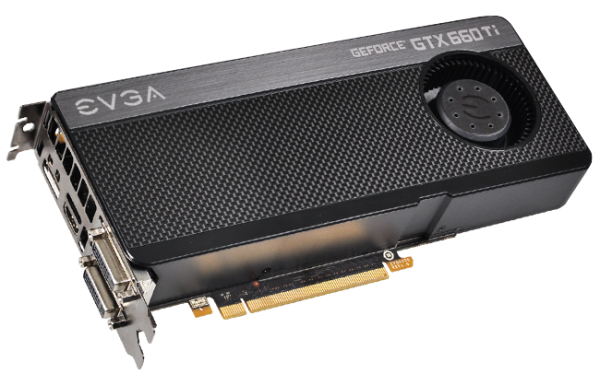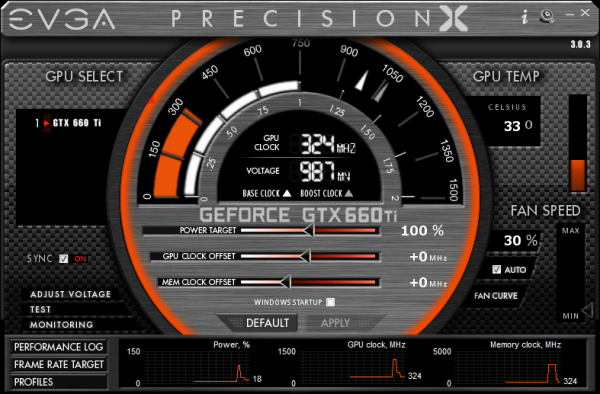The GeForce GTX 660 Ti Review, Feat. EVGA, Zotac, and Gigabyte
by Ryan Smith on August 16, 2012 9:00 AM ESTMeet The EVGA GeForce GTX 660 Ti Superclocked
Our first card of the day is EVGA’s entry, the EVGA GeForce GTX 660 Ti Superclocked. Among all of the GTX 670 cards we’ve looked at and all of the GTX 660 Ti cards we’re going to be looking at, this is the card that is the most like its older sibling. In fact with only a couple cosmetic differences it’s practically identical in construction.
| GeForce GTX 660 Ti Partner Card Specification Comparison | ||||||
| GeForce GTX 660 Ti(Ref) | EVGA GTX 660 Ti Superclocked | Zotac GTX 660 Ti AMP! | Gigabyte GTX 660 Ti OC | |||
| Base Clock | 915MHz | 980MHz | 1033MHz | 1033MHz | ||
| Boost Clock | 980MHz | 1059MHz | 1111MHz | 1111MHz | ||
| Memory Clock | 6008MHz | 6008MHz | 6608MHz | 6008MHz | ||
| Frame Buffer | 2GB | 2GB | 2GB | 2GB | ||
| TDP | 150W | 150W | 150W | ~170W | ||
| Width | Double Slot | Double Slot | Double Slot | Double Slot | ||
| Length | N/A | 9.5" | 7.5" | 10,5" | ||
| Warranty | N/A | 3 Year | 3 Year + Life | 3 Year | ||
| Price Point | $299 | $309 | $329 | $319 | ||
EVGA will be clocking the GTX 660 Ti SC at 980MHz for the base clock and 1059MHz for the boost clock, which represents a 65MHz (7%) and 79MHz (8%) overclock respectively. Meanwhile EVGA has left the memory clocked untouched at 6GHz, the reference memory clockspeed for all of NVIDIA’s GTX 600 parts thus far.
The GTX 660 Ti is otherwise identical to the GTX 670, for all of the benefits that entails. While NVIDIA isn’t shipping a proper reference card for the GTX 660 Ti, they did create a reference design, and this appears to be what it’s based on. Both the EVGA and Zotac cards are using identical PCBs derived from the GTX 670’s PCB, which is not unexpected given the power consumption of the GTX 660 Ti. The only difference we can find on this PCB is that instead of there being solder pads for 16 memory chips there are solder pads for 12, reflecting the fact that the GTX 660 Ti can have at most 12 memory chips attached.
With this PCB design the PCB measures only 6.75” long, with the bulk of the VRM components located at the front of the card rather than the rear. Hynix 2Gb 6GHz memory chips are placed both on the front of the PCB and the back, with 6 on the front and 2 on the rear. The rear chips are directly behind a pair of front chips, reflecting the fact that all 4 of these chips are connected to a single memory controller.
With the effective reuse of the GTX 670 PCB, EVGA is also reusing their GTX 670 cooler. This cooler is a blower, which due to the positioning of the GPU and various electronic components means that the blower fan is off of the PCB entirely by necessity. Instead the blower fan is located behind the card in a piece of enclosed housing. This housing pushes the total length of the card out to 9.5”. Housed inside of the enclosure is a block-style aluminum heatsink with a copper baseplate that is providing cooling for the GPU. Elsewhere, attached to the PCB we’ll see a moderately sized aluminum heatsink clamped down on top of the VRMs towards the front of the card. There is no cooling provided for the GDDR5 RAM.
Elsewhere, at the top of the card we’ll find the 2 PCIe power sockets and 2 SLI connectors. Meanwhile at the front of the card EVGA is using the same I/O port configuration and bracket that we saw with the GTX 670. This means they’re using the NVIDIA standard: 1 DL-DVI-D port, 1 DL-DVI-I port, 1 full size HDMI 1.4 port, and 1 full size DisplayPort 1.2. This also means that the card features EVGA’s high-flow bracket, a bracket with less shielding in order to maximize the amount of air that can be exhausted.
Rounding out the package is EVGA’s typical collection of accessories and knick-knacks. In the box you’ll find a pair of molex power adapters, a quick start guide, and some stickers. The real meat of EVGA’s offering is on their website, where EVGA card owners can download their wonderful video card overclocking utility (Precision X), and their stress test utility (OC Scanner X). The powered-by-RivaTuner Precision X and OC Scanner X still set the gold standard for video card utilities thanks to their functionality and ease of use. Though personally I’m not a fan of the new UI – circular UIs and sliders aren’t particularly easy to read – but it gets the job done.
Next, as with all EVGA cards, the EVGA GeForce GTX 660 Ti Superclocked comes with EVGA’s standard 3 year transferable warranty, with individual 2 or 7 year extensions available for purchase upon registration, which will also unlock access to EVGA’s step-up upgrade program. Finally, the EVGA GeForce GTX 660 Ti Superclocked will be hitting retail with an MSRP of $309, $10 over the MSRP for reference cards.






















313 Comments
View All Comments
wintermute000 - Thursday, August 16, 2012 - link
@ 720p the lower range of cards (ATI 78XX etc.) will destroy framerates even with everything turned up, there is no need to waste time benching!!!!!!!!!!!zlandar - Thursday, August 16, 2012 - link
Anyone notice how the 7950 went from 69 fps at 2560 x 1600 on the 5/10/12 review to 85 fps on today's review? That simply from improved driver performance?Ryan Smith - Thursday, August 16, 2012 - link
Correct. Beginning with Catalyst 12.7 AMD's Skyrim performance has significantly improved.thegr8anand - Thursday, August 16, 2012 - link
Just wondering, Toms say the performance of 660 is 3-4% below 7870 while Anand says its 10-15% more. What gives??Ananke - Thursday, August 16, 2012 - link
This is a castrated effectively 128-bit 24 ROPs hugely overpriced card. Best Buy had it for several days already, it is in the same green box as 560ti, and apparently nobody paid attention it was taken to the sale floor :). So, some people :):) already bought it, tried it, and can confirm it is not worth the money asked. In my sole opinion it can justify max. $199 at launch. It is disappointing. So, for whoever has and feels OK, GTX 670 for $400 is the way to go, otherwise pick up Radeon 7950 or 7870. I personally will choose the AMDs because of compute, NVidia current generation computing just plain sucks, but if you only play one game BF3 :):):) then maybe several hundred dollars is OK to spend on the GTXs.silverblue - Friday, August 17, 2012 - link
It's a 192-bit memory bus, not 128-bit.Different reviews have different setups. Toms seems to be the exception as regards the 7870 being superior; in general, the 660 Ti comes closer to the 7950. In some titles, it's shockingly fast.
If there was to be a standard 660, all NVIDIA could do here is to cut down the number of shaders and texture units - clocks won't do it as you'll just clock them back up again, and memory is already nerfed.
TheJian - Monday, August 20, 2012 - link
"Closer to the 7950"?? Careful, sounds like ignoring the evidence. BEATS it, and usually the 7970 (even ghz at times) too...see all my other posts...Pointless to even respond here?.. I've already written every game at hardocp, anand show victories for Skyrim, Batman AC, Witcher2, Battlefield3, Battlefield 3 Multiplayer, Portal 2, max payne 3...That rules out HardOCP I guess. Anand added a few more, Shogun 2 (another landslide for 660 TI, even against 7970), Dirt3 used here anand - Wash (though minimums do show Nvidia as Ryan points out)...
Civ5, landslide again at 1920x1200 here anandtech...Metro2033 here anandtech, <5% win for Nvidia %1920x1200 (I call it a wash I guess)...
So which game can I point to that will be OK to you? I'll try to help you let AMD win...:)
Understand Tomshardware, turned all cards to default...So you buy a card and downclock them all to test...ROFL "we dropped each card's clock rates to reference levels." from page 2 of their article:
http://www.tomshardware.com/reviews/geforce-gtx-66...
That same page 2 from their review at the bottom of the graphics card list:
"All overclocked cards reduced to reference specification for testing"
So, every card will perform UNLIKE what you would buy on either side. Their review is worthless as they are nerfing even ATI cards. Though it hurts NV more. I'm not sure why they even ran the benchmarks...They should have just said look elsewhere for real answers to how these will perform when you buy them out of the box. Nobody else did this, which is why they are ODD in their results.
CeriseCogburn - Thursday, August 23, 2012 - link
That's great them Tom's Hardware can put 100% or near so amd cards in their bang for buck monthly again perpetuating the big lie, jiggering the price categories up or down depending on what makes amd fanboys gleeful. It's so ridiculous they get best card for 115, best card for 155, then next month, best card for 90, best card for 135 ETC, and then they squish the crap amd card in just uner the number, and their attached price link shows it 50 bucks higher on the day of their postYou thought this place was bad ? LOL
Then the rabid amd fans at toms put a minus 20 on every comment that doesn't kiss the amd quite often. They're goners.
They do have more than 1 reviewer, so some times you'll get something sane, but not very often. It's been degrading for a long time, it's really sad.
CeriseCogburn - Sunday, August 19, 2012 - link
nVidia's profits and sales show very few people are amd fanboyyed out like you are.I recommend not believing nor following a word of advice from you.
claysm - Friday, August 17, 2012 - link
It has a lot to do with what settings are being used in-game. The Tom's article admits at the end that their setup could be AMD favored, since they tend to prefer high levels of AF and AA, which eat up memory bandwidth and heavily tax the memory subsystem (a strong point for AMD).